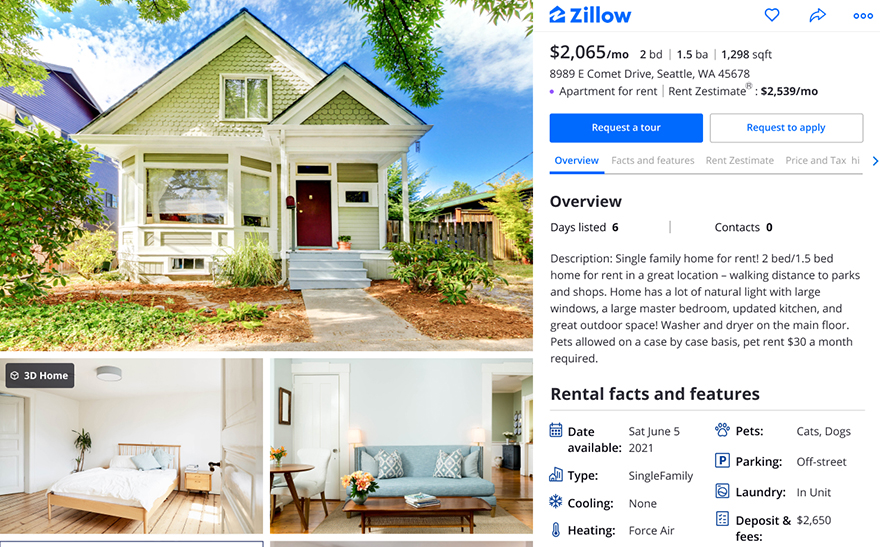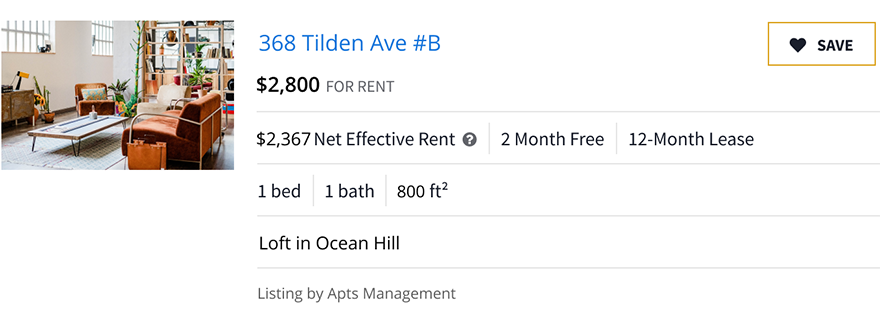How to Write a Rental Ad


Just like a lackluster resume or a poorly written college application essay, a mediocre rental listing can easily get lost in the crowd. Remember — people are looking for a place to call home. Here are the key elements to include in a rental ad when you list your house for rent online:
According to the Zillow Rentals Consumer Housing Trends Report 2020, 60% of renters said their moving date was flexible or negotiable. Taking the time to create an attractive and informative listing not only helps you catch the eye of potential renters with time on their side, but can also save you time in the long run.
When rental shoppers don’t have much info about your rental home, you might find many conversations end with “Oh, that’s not really what I was looking for.” But informed renters will be one step closer to deciding about the rental before they contact you — reducing the number of dead-end calls, emails and tours. The top questions people ask about rental listings may surprise you! Use our tips below, along with our listing creation checklist (select the green button at the top of this page to download it), to craft a winning rental ad.
When renters are shopping for a new place to call home, they’re comparing listings to their “must-have” and “nice-to-have” features. See what those features are: Click here to access our free renter fact sheet for a wealth of information about renter preferences and expectations.
Including relevant information in your ad for a rental house will save time for both you and the renter. Be sure to cover this key info:
Make sure prospective renters can afford your property by clearly stating the asking rent, application fee, security deposit, utilities and lease term. Also include any pet or HOA fees if applicable — many renters could pass on a home that isn’t transparent about these details.
Help renters visualize the layout of the rental by posting a floor plan — details that photos alone can’t provide. When looking for a rental, 52% of renters consider this information very or extremely important. In fact, 42% of all shoppers said layout was highly important to them, and 45% said the same about square footage.
Things like storage, flooring material and energy-efficient upgrades will help set your listing apart from the rest when you advertise your rental. Some unique features to include, if applicable:
Flooring: Is it hardwood? Laminate? Concrete?
Natural light and windows: Having lots of windows can make a big difference to renters, especially if the house is smaller. Call out any oversized and floor-to-ceiling windows.
Storage and closets: Make sure you let prospective renters know about any walk-in closets or pantries, as well as any large closets or storage space.
Appliances: Top-priority amenities often include air conditioning, a dishwasher and in-unit laundry (55% of Gen Z renters, 53% of Millennials, and 40% of Baby Boomer and Silent Generation renters consider this feature highly important). Let the renter know if the kitchen has desirable features like stainless steel appliances or a double oven.
Smart home features: Wireless doorbells, smart thermostats and other electronics can add value for many prospective renters.
Energy efficiency: Energy-efficient features are important to 37% of renters.
Utilities: List what utilities are included (if any), as well as what’s available (cable/satellite TV, internet, etc.).
Parking: Is there a garage? Covered/assigned parking? Are there any parking fees?
Pet owners will pass over listings where pets are non-negotiable, which immediately excludes a large group of potential renters — more than half (51%) of renters reported having at least one pet. Also include any other major rental restrictions like HOA regulations.
Viewing photos of the home is described as extremely or very important by 60% of renters — so a listing with poor photos may not receive much attention, and one without any photos may not even receive a second glance. Use these tips when listing rental properties to maximize visibility:
When creating rental advertisements, pictures are essential to help prospective renters visualize the space. Use these eight tips to help maximize your rental’s appeal:
At a minimum, give the tenants 24 hours’ notice. (Note that some jurisdictions require more advanced notice. Consult your local rental housing laws to determine your specific obligation.)
Politely ask them to make sure the space is clean — you can even incentivize this by discounting that month’s rent or giving them a small gift. Quality photos of an uncluttered house aren’t just good marketing — they’re a subtle prescreening tool for prospective renters. Shabby photos are more likely to deter renters who take pride in their home, potentially leaving you with contacts who are less concerned about keeping up the property.
Pros of photographing an occupied home: The space will have furniture, giving it a homey feel.
Cons of photographing an occupied home: You likely won’t have control over what furniture is in the photos, and the space may not be as clean as you would like.
Staging is key. If you’re able to stage the home with furnishings, you’ll give renters an idea of how much space they’ll have. You can even make rooms feel larger with effective staging.
Pros of photographing a vacant home: You can take photos from a wider range of angles and stage the house as you like. You don’t have to worry about intruding on renters or working around their schedules.
Cons of photographing a vacant home: Empty spaces can be less inviting — and if you stage the house, you’ll have to move furniture.
In addition to posting photos, you can take your rental ad listings to the next level with Zillow 3D Home virtual tours. The rich media features capture the layout of the home, helping renters picture themselves in the space to see if it meets their needs. Read our 3D Home Guide to learn how to use this feature — it’s easier than you might think!
In addition to the rent price, deposits, fees and lease term, be upfront about any policies that could be deal breakers (or deal makers) for prospective renters. Disclose your policies on pets, smoking, noise, parking and anything else that might affect a rental decision. For example, if a garage is visible in your photos but it’s not available for tenant use, be clear about that in your description. A less-specific listing might generate more inquiries, but if those renters won’t qualify because, for example, they have pets and you don’t allow them, you won’t rent your property more quickly.
If your rental has access to community amenities, such as a laundry room, pool, fitness facility, barbecue area, lawn or rooftop deck, list the ones available for tenant use. Among Gen Z renters, 27% say shared spaces like pet, conference or business areas are extremely or very important to them. More than 30% of them also highly value a shared fitness center or gym, and 24% of Millennial renters agree. Also note if the building has secured access, and whether the landlord or property manager lives on-site.
When renters are looking for a new home, the property itself is not the only factor in their rental search. Including information about the home’s proximity to transit, shopping, libraries, pools or other area features can influence a renter’s decision to contact you. Point out anything that makes the neighborhood desirable — especially if it’s not obvious to someone just driving by. For example:
Remember to avoid descriptions that might violate fair housing laws, even if they seem harmless. For example, don’t use phrases such as “nice quiet area for adults only” or “large Asian community.”
Timing is important for busy potential renters. According to data gathered from Zillow’s Tour Availability feature, Thursdays are ideal days to post because renters want to schedule tours soon after they see your rental ad. The upcoming weekend will maximize your availability for tours. And offering evening tours is important; it’s when renters most want to tour potential rentals.
After rental shoppers have figured out how many bedrooms they want and whether they need in-unit laundry, there are more amenities to consider. You’ve already addressed their primary concerns — so any additional details you provide will help your rental ad stand out among comparable properties.
For tenants who have pets or children, or those who like to entertain, having a yard or patio can be a huge draw. Private outdoor space is particularly sought-after: 40% of renters view that feature as very or extremely important.
Some tenants want more than a lock on the windows and doors, especially in urban areas. The presence of a security system, keycard entry, deadbolt locks or a fenced yard can help prospective applicants feel safe.
Do you live on-site, or do you use a company to manage your rental? Some tenants prefer their landlord or property manager to be close by so repair requests and maintenance can be taken care of quickly. Others appreciate the privacy of having an off-site property manager.
Find out what else renters are looking for: Download our free renter fact sheet for information about renter preferences and expectations so you can make more informed decisions about what features to highlight when marketing your property.
Have someone else look over your ad before you post it. Make sure to catch any spelling errors and check that you’ve included all the pertinent features and amenities of the property. A poorly written or disorganized description may turn away some prospective renters.
There are many different platforms to showcase a house for rent ad. Some options include:
Zillow Rental Manager makes it easy to list your property on the largest rental network on the web.* You only need to create one listing — we’ll post it across Zillow, Trulia, HotPads and other rental websites in our network.
The below image is an example of a house rental ad on Zillow.

New York City has many regulations around renting a home or apartment. StreetEasy is a NYC-exclusive network for apartment sales and rentals.
Here is an example of a rental ad on StreetEasy:

*Zillow Group’s custom-defined rental networks category ranking based on U.S. Media Metrix comScore data, Unique Visitors, April 2019.